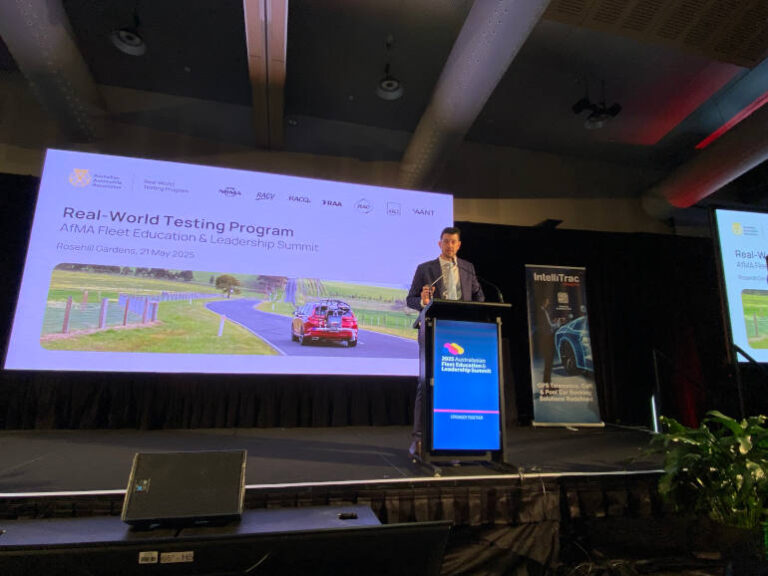At AfMA 2025, the Australian Automobile Association’s Jason Smith delivered a polished presentation on the AAA’s Real-World Testing Program—an initiative designed to expose the difference between lab-tested and real-world fuel consumption figures. It’s a great resource for consumers. But here’s the uncomfortable truth: Fleet Managers should already know this. The fact that this had to be explained—at a fleet industry conference no less—speaks volumes about the current state of fleet procurement and operational oversight in Australia.
Smith was respectful and informative, walking through how the AAA tests vehicles on a controlled real-world route to uncover actual fuel usage, tailpipe emissions, and CO₂ output. The results, freely available on the AAA’s website, often diverge sharply from the glossy showroom stickers.
“We’ve seen vehicles using up to 35% more fuel than their lab ratings suggest,” Smith explained. “And in some rare cases, a few have used less.”
But the real takeaway wasn’t the numbers—it was the question that hung unasked in the air: Why don’t Fleet Managers already know this?
This Isn’t New—It’s Just Being Ignored
Any Fleet Manager worth their job should be comparing vehicle fuel usage claims to real-world results. This isn’t a new concern. The “lab vs road” gap has been widely known since the Volkswagen emissions scandal almost a decade ago. The fact that Smith’s presentation felt revelatory to some in the audience is worrying.
If you’re outsourcing your fleet to a Fleet Management Organisation (FMO), they should already be factoring this into your TCO analysis. If you’re running your fleet in-house, you should be looking at fuel card data, exception reports, and historical fuel usage patterns. If you’re not, you’re either overpaying or overlooking fuel fraud—or both.
Where’s the Accountability?
Fuel is a top-three fleet cost category. If your vehicles are underperforming, that’s not just inefficiency—it’s waste. It might even be theft. The AAA’s real-world data can be used to flag vehicles that are consistently over-consuming fuel. If you’re not benchmarking against something like this, what are you using?
Jason Smith gently reminded the audience that “there is no rule of thumb.” Two hybrids, both marketed similarly, delivered wildly different results in AAA testing. One used 10% more fuel than its lab figure, another 31% more. Yet both wore a green badge and came with sustainability promises.
This isn’t obscure detail. This is fundamental to fleet cost management, carbon reporting, and operational performance. And yet it’s being treated like news?
Why Was This Even on the Agenda?
Let’s be blunt: the Real-World Testing Program should not have needed a 20-minute timeslot at an industry summit that bills itself as the leading event for fleet education and leadership. Its inclusion—while the program itself is excellent—felt almost like a rebuke.
Are Fleet Managers no longer doing their own diligence?
If this had been presented at a community open day or a consumer roadshow, it would make perfect sense. But at AfMA, with a room full of professionals managing tens of thousands of vehicles, it landed like a reality check. If the reaction from the audience was one of surprise, that’s the real problem—not the test results.
Fuel Fraud: The Unspoken Issue
And then there’s the darker side: fuel theft. If your vehicles are using 20% more fuel than expected, and there’s no mechanical fault, no major route changes, and no performance drop—someone could be filling their lawn mower, their mate’s Hilux, or worse.
The AAA’s data offers the perfect control benchmark. If your reports show higher fuel use than what AAA records under near-identical conditions, you’re armed with the evidence to investigate. Ignoring it is negligent.
It’s Not About Blame—It’s About Standards
Smith’s work is valuable. The AAA’s program is robust, evidence-based, and public. But it shouldn’t be groundbreaking in fleet circles. It should be background noise—already baked into procurement systems, budgeting tools, and environmental reporting dashboards.
Instead, it’s a wake-up call.
Final Word: Use the Data or Rethink Your Role
Fleet Managers don’t get to play the “we didn’t know” card anymore. The data is free. It’s Australian. It’s tested on local roads using local fuel. If you or your FMO aren’t integrating it into fleet decision-making, you’re not managing a fleet—you’re just reacting to bills.
It’s time to raise the bar. Jason Smith did his job. Now Fleet Managers need to do theirs.
How to Access the AAA Real-World Test Results
The AAA Real-World Testing Program makes independent fuel consumption and emissions data available free of charge. Here’s how Fleet Managers can access it – Go to: www.realworld.org.au – The data is updated regularly, with the first electric vehicle results to be published from July 2025.
What you’ll find:
- Fuel consumption (L/100km) in real-world driving
- CO₂ emissions and tailpipe pollutants
- Side-by-side comparisons for hybrids, petrol, diesel, and (soon) EVs
Test methodology: Each vehicle is driven on a fixed 93 km route around Geelong in real traffic, covering urban, rural and motorway conditions.
Filter results by vehicle type, drivetrain, or segment to build your own benchmark data for procurement decisions or fraud checks.






